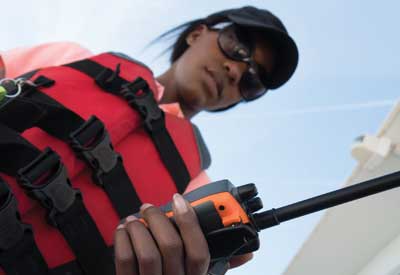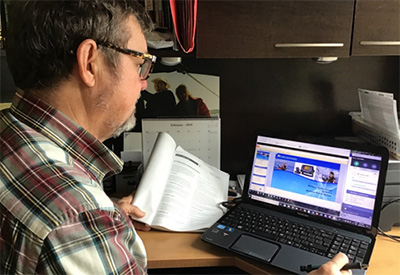Maritime Radio Course to integrate use of DSC

Mar 28, 2019
During the course of the past year, the Maritime Radio Course committee has been working diligently, primarily through teleconferencing, to revise the Maritime Radio Course..
The requirement to change the course was primarily driven by the fact that Digital Select Calling (DSC) has become a standard on the radios used by the recreational boating community as well as some commercial operators such as whale watching tour operators and near shore towing vessels.
The primary purpose of DSC is to enable boaters to contact other vessels or shore stations without using the Distress voice calling channel (16) or Medium Frequency (MF) 2182kHz leaving those channels and frequencies clear for emergency communications. DSC is also very effective in transmitting emergency communications and hastening response times in those circumstances. Given that this is what was being promulgated it seemed logical to incorporate DSC as a normal rather than special procedure in both operating a radio and in teaching the course.
This is precisely what has been accomplished in re-writing the manual and consequently revising the course.
The manual was previously divided into two main modules: the first one dealt with the voice calling procedure and the second focused on The Global Maritime Distress and Safety System (GMDSS) and the use of DSC. The revised course and manual now fully integrate the use of DSC and radio voice calling procedures.
Revising the course has led to the following improvements:
• Development of an interactive on-line study guide which replaces the previous review exercises than were on the CD. It includes interactive practice exercises in formatting Distress, Urgency and Safety calls.
• a shorter integrated manual of 10 Sections and 6 Appendices. The old course had 2 Modules of 7 Sections each which frequently overlapped, and, treated GMDSS and DSC as add-ons. In addition, there were 14 Appendices.
• Clarification of which commercial operators can use the ROC(M) rather than requiring an ROC(MC)
• New coloured graphics showing GMDSS concepts, how to use DSC and illustrating other GMDSS equipment.
• New PowerPoint presentations some of which integrate YouTube clips. The presentations also have notes attached to each slide to help instructors with their presentations. Instructors are encouraged to modify the presentations to suit their teaching style and to add items of local interest to the course.
• a revised instructor guide that will assist instructors in transitioning to the new course and that will also include suggestions for using the VHF Simulator
• an updated course exam in which the DSC questions are no longer in a separate section but are found throughout the examination.
• As a result of these changes it will no longer be possible to teach a DSC upgrade course for people who have their ROC(M) but do not have the DSC endorsement. The DSC material has now been integrated throughout the course and the revised exam and is no longer in a standalone module.
• Course exam instructions have been integrated with the exam instructions for the PCOC. With the exception of pass/fail standards the administrative procedures are now the same (it made no sense to have two sets of instructions)
• A reduction in course material; there will no longer be an accompanying CD (some statistics suggest only 30% of students were using it). The phonetic alphabet book mark will be incorporated into the manual for individual photocopying or available as a download.
Both French and English versions of the revised course should be ready at approximately the same time. The committee revising the course ensured that after sections were completed, revised by the English Editorial Review Committee and finalized, they were immediately sent to the French committee for translation and review.
The committee’s work is now nearly complete, and the new Maritime Radio Course materials are expected to be available this spring. All instructors must familiarize themselves with the new manual and power point presentations. It is anticipated that the new materials will be available to students this coming summer.
In conclusion, the revised course more fully integrates the use of DSC and radio voice calling procedures teaching students how to take advantage of the capabilities of GMDSS compatible radios for establishing communications at sea.
 Committee Member teleconferencing (Image source: Photo by Linda Romaniec)
Committee Member teleconferencing (Image source: Photo by Linda Romaniec)
In addition to this photo any of the images or graphics in the book could be used to enhance the article





























